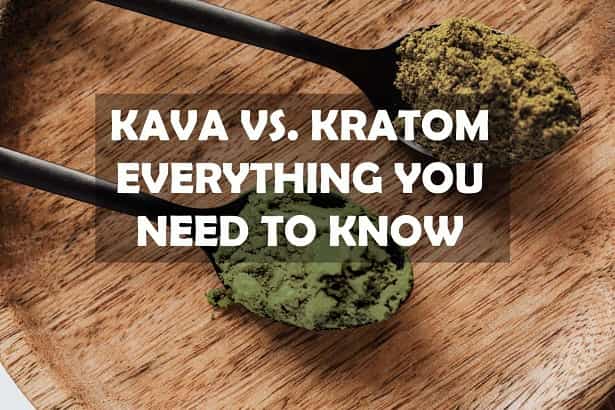If you’re into the natural healing culture, you’ve probably heard of two words that are generating plenty of buzz—Kava & Kratom.
But while they are increasingly being sold alongside each other at health food stores and online, have similar names, and kind of look alike when prepared, the truth is they’re still world’s apart.
This article will discuss how the two herbs are different and where they may be similar. Also, we’ll explore where each of these natural healing plants excels and where they fall short.
Let’s get started.
Kava Vs. Kratom—The Basics
First things first, let’s discuss the basics of the two natural plants.
Kratom, aka mitragyna speciosa, is a tropical herb belonging to the coffee family and is native to Southeast Asia, mainly Thailand, Indonesia, and Malaysia. You can find the herb in various strains-Each come with a unique chemical makeup and render different effects on the body.
Classifying the herb is not easy. There are plenty of different classification systems available. However, in general, this evergreen tree can be classified into four main strains;
- White Vein—Highly Sedating
- Red Vein—Stimulating
- Green Vein—Energizing
- Yellow Vein—Euphoria
While all the strains have unique effects, they all have discomfort-relieving properties in common. When you consume it in a lower dose, the herb acts as a mild stimulant—Just like coffee. But when the dose is increased, its effects lean towards sedation and sleep induction.
As for Kava, aka Piper methysticum, also a tropical plant, belongs to the pepper family. This evergreen tree is native to remote islands in the Western Pacific, namely Vanuatu, Fiji, Papua New Guinea, Micronesia, and Hawaii.
You’ll be surprised to know that this herb is a few of the only natural plants on earth that doesn’t produce any seeds. And relies entirely on humans to reproduce. Framers have been cutting parts of the roots and planting them on new islands. So essentially, they are all copies of the same plant.
However, plant genes have been forced to evolve with time. And you can now find this natural plant in various strains—Long slender stocks with euphoric effects & Short thick stocks with sedative effects.
While the different strains of Kava have their unique sets of effects, their basic effect profile remains similar—Reduces stress, relaxes muscles, enhances mood, and supports sleep.
How are Kava and Kratom Similar?
To begin with, let’s talk about the similarities between the two herbs.
Both Kava and Kratom are natural plants. You can ground both the plants into tea and consume it for their various healing effects. Or you could conveniently consume the herbs in a pill.
Another similar factor for the two natural plants is their effects. Both the herbs can have a stimulant or sedative effect, depending on the dose. This means that you can opt for either herb for relaxation, sleep improvement, pain relief, and to boost energy.discomfort
How are Kava and Kratom Different?
Effects
The effects of mitragyna speciosa entirely depend on the type of strain you consume. Say you consume Bali Kratom; the effects will lean more towards euphoria and mood elevation. On the contrary, a strain like Maeng Da acts more like an analgesic and a stimulant.
But when it comes to this herb’s effects, the dose matters too. If used in small doses, the effects are stimulating and energizing. But if you consume the herb in larger doses, you’ll experience sedation and calmness. Keep in mind that very high doses of this natural plant could lead to side effects, including dizziness, tiredness, and nausea.
As far as Kava goes, its effects are mostly sedating. Users usually consume the herb for better sleep and to relax. The herb also enhances mood by affecting a particular brain area associated with emotions.
Pharmacology
Speaking of Kratom, it contains alkaloids. And the alkaloids react with specific receptors in your brain to render various effects. While the research on this evergreen tree is limited, the primary psychoactive ingredients are the alkaloids, namely mitragynine and 7-hydroxymitragynine.
The unique chemical makeup of this herb is responsible for a plethora of effects, including discomfort relief, mood enhancement, energy boost, and sleep induction.
And as for Kava, the pharmacology is quite different. As opposed to Korth, the scientific research into the chemistry of Kava and its effects is more extensive.
When it comes to this plant, the main ingredient, i.e., Kavalactones, is responsible for over 90% of the active natural ingredients in the plant. They react with our limbic system—the part of the body associated with emotions, behavior, and motivation. Unlike the alkaloids in Ketum, your body doesn’t quickly develop a tolerance to the Kavalactones.
Origin
While both the herbs are tropical plants, they originate from entirely different world regions.
Kratom—a member of the coffee family(Rubiaceae)—comes from Southeast Asia, particularly Malaysia, Thailand, and Indonesia.
On the other hand, Kava belongs to the pepper family(Piperaceae) and originates from remote islands in the Pacific Oceans, including Fiji, Vanuatu, Tonga, Hawaii, and Samoa.
Preparation & Consumption
For those of you who want the nitty-gritty details about how you can prepare and consume the two all-natural herbs, let’s cover the key differences between the two plants.
Part of the pepper family, kava (Piper methysticum), is found naturally in Polynesia, Fiji, and other Western Pacific islands. While its heart-shaped leaves are mainly for show, the roots of this evergreen tree contain the active compound, i,e kavalactones.
You can grind the roots into a paste, add some water, strain and consume it right away. Or you could prepare kratom as tea. But nowadays, it’s usually ingested as a tincture, powder, or in a capsule.
As for Mitragyna speciosa, it belongs to the coffee family and is native to Malaysia, Indonesia, Thailand, and other areas of Southeast Asia.
You can consume this natural plant in many ways, namely powder, tea, capsules, tinctures, and caping e-juice. Or you could simply chew the fresh leaves. While it may taste bad, it’s extremely useful in harnessing all of the herb’s properties.
Dosage
Just like with anything else, the amount you consume is crucial in determining its effects.
A typical dose of Kava is anywhere between 70 to 250 mg. And the recommended daily maximum dose is 250mg. Comparatively, the ideal daily Kratom intake is anywhere between 2 to 8 grams.
Regardless of the herb you’re consuming, you must take it slow. For starters, buy a scale to measure the dosage accurately. Start with the lowest recommended dosage. And gradually increase your dosage to an amount you feel works best for your individual needs.
Click here to find the right kratom dosage.
Legality
Unfortunately, Kratom is involved in a heated legal battle that may lead to a total ban in the United States. Currently, the herb is legal in a few US states. You can check the legal status of the herb in your state here.
And as far as Kava goes, it’s totally legal in the United States and has been for over 20 years. Today, the herb is gaining immense popularity as a natural health and beauty supplement around the globe. Numerous Kava bars have popped up across the country. And individuals are consuming the herb as an alternative to alcohol as a natural form of relaxation.
Kava Vs. Kratom— A Breakdown Chart
| Kava | Factor | Kratom |
| Western Pacific Islands(Fiji, Samoa, Vanuatu, etc.) | Origin | Southeast Asia(Malaysia, Thailand, Indonesia, etc.) |
| Mitragynine7-hydroxymitragynine | Active Compound | Kavalactones |
| GABAergic Dopaminergic | Pharmacology | Dopaminergic Acts on Serotonin and Norepinephrine Receptors |
| (Root)Powder Tea Grind the Root into a Paste with Water Capsules | Preparation | (Leaves)Tea Capsules Vape /Smoke Tinctures Extracts Powder Chew Fresh Leaves |
| Relieve discomfort Mild Stimulation Reduces StressInduce Calmness | Effects(Low Dose) | Boost Energy Energizing |
| Sedation Reduce Cancer Risk Muscle Relaxation Euphoria | Effects(High Dose) | Reduces discomfort Reduces Stress Induces Sleep Euphoria |
| 2 to 5 hours | Duration of Effects | 2 to 5 hours |
| 10 to 15 minutes | Onset of Effects | 10 to 15 minutes |
| 70 to 250 mg | Dosage | Low-1 g Mild-1 to 2 g Moderate-2 to 4 g Potent-4 to 6 g Very Potent-6 to 8 g Above Limit-8 g and above |
| May Interact With Other Drugs | Side Effects | Nausea Vomiting Tolerance |
| Legal In All States in the US | Legality | Legal in Some States in the US |
Can I Mix Kava with Kratom?
Before we dive into the details, let me get one thing straight. Mixing herbs can lead to unexpected results. This is why you need to be extremely careful when doing so.
Because Kava and Kratom havs similar effects, mixing them can yield more substantial results— A concept known as synergism. You can mix the two herbs and enjoy the best of both worlds.
But here’s the problem. Since both the natural plants are prepared differently, mixing them properly in the correct dosage can be difficult. Where Kava is mixed with water using a strainer to keep the fibers away from the mixture, Kratom powder is simply mixed into water and consumed as it is.
But it’s simple. All you need to do is mix in the Kava first, and later on, add Kratom powder to the final brew. You can start by adding the Kava to water through a filter for 10 to 15 minutes. Once it is fully dissolved, you can go ahead and stir in the Kratom powder. Keep the total mitragyna speciosa dose around 10 to 20% of the total dose.
The reason why we follow this order is because Kava dose is much higher. And the higher dose always goes first.
Kava Vs. Kratom—The Takeaway
We’ve established that while the two herbs share some similarities, they are vastly different on a deeper inspection.
Where Kava uses the GABA system to render its effects, Kratom acts on the serotonin and the norepinephrine receptors in your brain. And this difference leads to their unique effects profile—Kava for enhancing creativity, increasing focus and muscle relaxation, & Kratom for relieving discomfort and stimulation.
And if you’re unsure of what to take, the good news is that you can take them together and enjoy the best of both worlds.
Just remember to take it slow and gradually build up your dose to what you feel suits you best.




One Comment
I would love to try your samples as I am just learning.